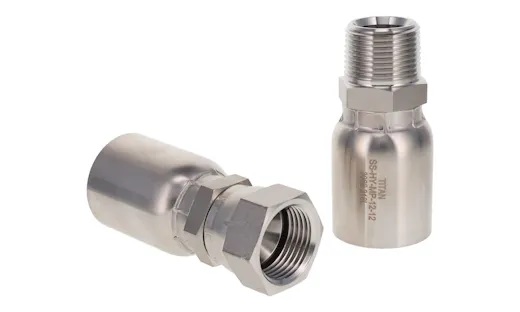Introduction
Hydraulic systems depend on reliable and secure connections between hoses and equipment. The end fittings on hydraulic hoses are essential for creating these connections, ensuring that the system operates safely under high pressure without leaks or failures. This blog will explore six common types of hydraulic hose end fittings: crimp fittings, hose barbs, push-lock fittings, quick connects, compression fittings, and reusable fittings. We’ll discuss their designs, advantages, and typical applications to help you make an informed choice based on your specific needs.
1. Crimp Fittings
Design: Crimp fittings are permanently attached by using a crimping machine to deform the fitting around the hose, creating a strong, leak-proof seal. These fittings can be made from various materials, including stainless steel, brass, and other alloys, offering flexibility in application.
Applications: They are commonly used in high-pressure environments such as manufacturing, automotive, and heavy machinery, where durability and long-term reliability are essential. These fittings are ideal for situations where disconnection is rare or not required.
Benefits: Crimp fittings offer a strong, secure connection with minimal risk of leakage. They are versatile, available in many sizes, and suitable for a wide range of industrial uses.
Shop Crimp Fittings
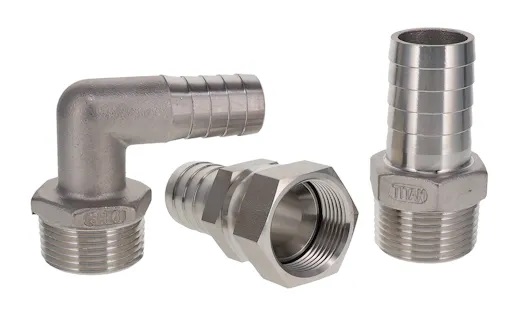
2. Hose Barbs
Design: Hose barbs feature a ridged stem that inserts into the hose, often secured with a clamp. They don’t require special tools, making them easy to install on-site for quick repairs.
Applications: Commonly used in low to moderate pressure systems like residential water lines, workshop air hoses, and agricultural fluid transfer systems.
Benefits: Their simplicity and cost-effectiveness make them ideal for temporary or occasional use. Installation is fast and requires no complex tools.
Shop Hose Barbs
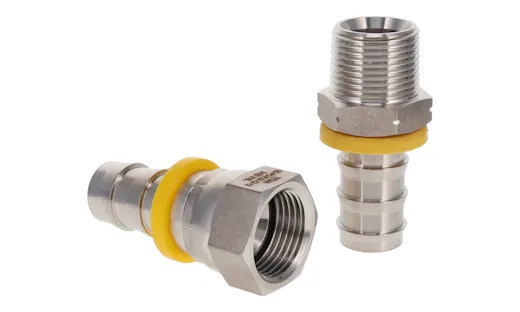
3. Push-Lock Barbs
Design: These fittings allow for tool-free installation, with the hose simply pushed onto the fitting until it locks in place. A gripping ring inside ensures a secure hold.
Applications: Ideal for low-pressure hydraulic and pneumatic systems, especially where frequent assembly and disassembly are needed, such as in automotive or industrial settings.
Benefits: They save time and reduce labor costs due to their ease of use. They also provide a clean, professional look and are great for flexible setups.
Shop Push-Lock Barbs
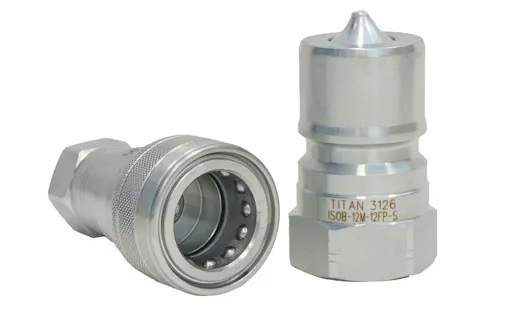
4. Quick Connects
Design: Quick connect fittings feature a push-pull mechanism for fast and tool-free connection and disconnection. They typically consist of male and female parts that lock together securely.
Applications: Used in systems requiring frequent hose changes, such as construction equipment, agricultural machinery, and chemical plants.
Benefits: They minimize downtime and reduce fluid loss during disconnection, making them ideal for handling hazardous or expensive fluids.
Shop Quick Connects
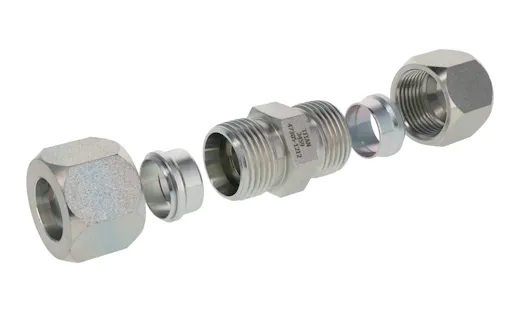
5. Compression Fittings
Design: Compression fittings use a nut and ferrule to compress the hose when tightened, forming a tight seal. No flaring is required, making them simple to assemble.
Applications: Suitable for medium-pressure systems like fuel lines, refrigeration units, and general hydraulic setups where disassembly is needed.
Benefits: They are leak-proof, easy to install, and durable. They work well in systems that require regular maintenance or reconfiguration.
Shop Compression Fittings
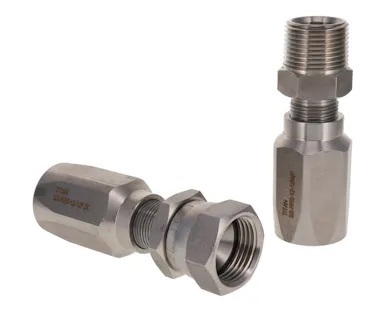
6. Reusable Hose Fittings
Design: Reusable fittings are designed for field assembly and disassembly without special tools. They usually consist of a body, a socket, and sometimes a nipple, allowing the hose to be compressed and secured.
Applications: Ideal for emergency repairs, remote locations, and situations where hoses need to be frequently reconfigured or reused, such as in marine or construction environments.
Benefits: They are cost-effective, sustainable, and reduce downtime. They eliminate the need for expensive crimping machines and allow for repeated use of both the hose and fitting.
Shop Reusable Hose Fittings
Conclusion
Selecting the right hydraulic hose end fitting is essential for maintaining the performance, safety, and longevity of your hydraulic system. Each type of fitting has its own strengths and is suited to different applications. Whether you need a permanent, robust connection or something that can be quickly assembled and disconnected, understanding the options helps you choose the best fit for your specific needs.
Q & A
Q1: What are hydraulic hose end fittings used for?
A1: Hydraulic hose end fittings are used to connect hoses to components like pumps, valves, and cylinders. They ensure secure, leak-free connections capable of handling high pressure and harsh conditions.
Q2: How do you choose the right hydraulic hose end fitting?
A2: Choosing the right fitting depends on several factors, including pressure requirements, compatibility with the hose and fluid, environmental conditions, and the specific application. It's important to match the fitting type to the system’s demands.
Q3: Can hydraulic hose end fittings be reused?
A3: Yes, some fittings like reusable or field-attachable ones can be reused multiple times. However, crimp fittings are permanently attached and cannot be reused once removed.
Q4: What is the difference between crimp and reusable fittings?
A4: Crimp fittings are permanently attached using a crimping machine, while reusable fittings can be manually assembled and disassembled without special tools. Reusable fittings are more flexible but may not be as strong in high-pressure environments.
Q5: Why would you use a quick connect fitting in a hydraulic system?
A5: Quick connect fittings are used when there is a need for frequent disconnections and reconnections without tools. They help reduce downtime and prevent fluid loss, making them ideal for maintenance-heavy systems or mobile applications.
Metal Bracket,Bracket Inspection Fixture,Aluminum Checking Jig,Retainer Inspection Fixture
JING SUNG Precision CO., , https://www.jingsungcnc.com
